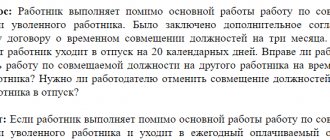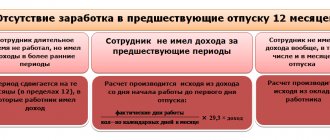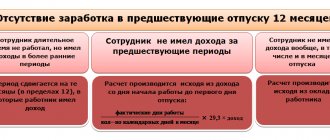What is part-time work
As follows from the provisions of Article 282 of the Labor Code of the Russian Federation, part-time work is the performance by an employee of other regular paid work under the terms of an employment contract in his free time from his main job.
Accordingly, the main features of part-time work are: a separate employment contract and the performance of job duties only at a time when the person is not busy at his main place of work. As a general rule, a part-time worker can work for each employer for a maximum of 4 hours a day. Longer part-time work is possible if a person is free from his main job that day and in other cases listed in Article 284 of the Labor Code of the Russian Federation.
Payment for part-time work is made in proportion to the time worked (Article 285 of the Labor Code of the Russian Federation).
Calculate advance and salary taking into account all current indicators
Features of part-time work
A part-time worker must manage to fulfill his duties at two or even several jobs, so his work schedule will have some features. Working hours are recorded in a time sheet, and an employee with an internal part-time job can be assigned two personnel numbers. The salary of a part-time worker is calculated according to the terms of the employment contract. Payment can be hourly, piecework or on any other terms.
When recording the working time of a part-time worker, you must pay attention to ensuring that the additional working time does not exceed half of the standard working time for the accounting period. For example, if in October the standard working time with a 40-hour weekly workload is 176 hours, then part-time working hours cannot be more than half of this standard, i.e. 88 hours per month.
A part-time worker can also be involved in overtime work, in excess of these norms, but must comply with the norm of overtime hours (no more than four hours for two days in a row and no more than 120 hours in the general accounting for the year). Payment for overtime hours is carried out as usual, according to the norms of Article 152 of the Labor Code of the Russian Federation (no less than one and a half times the amount for the first two hours, and no less than double the amount for all subsequent hours).
A part-time worker is provided with annual paid leave during the same period as at the main job. To confirm the date of leave, the employee must present a certificate or a copy of the leave order from his main job. The total duration of vacation during part-time work does not increase, but vacation pay is calculated taking into account the earnings received.
If an employee at a part-time job has not yet worked the required six months, then he must be given leave in advance. Depending on the position and category of the employee, the duration of vacations at the main job and part-time job may vary. In this case, to combine vacation periods, the employee may be given several days without pay.
A part-time employee may be sent on a business trip. When the part-time job is internal, the employer takes into account only his own interests, and problems with choosing the timing of the business trip do not arise. If the places of work are different, you can send a part-time worker on a business trip only for the time when he is free from his main job.
In the event that the time of a business trip for a part-time job cannot be rescheduled, employers must enter into an agreement among themselves on the order in which the employee will perform his job duties for this period (Resolution of the Government of the Russian Federation of October 13, 2008 No. 749). Of course, in practice such agreements are of little use, because a business trip is rarely so short that the employee has time to return to his main place of work the next day. But it is possible to agree that the employee will take several days without pay at his main job. Travel expenses are, of course, borne by the employer who sent the employee.
During the illness of an internal part-time worker, he is paid one temporary disability benefit based on one sheet, but taking into account the average earnings at all jobs. If the employers are different, then several certificates of incapacity for work are issued to be provided for each place of work.
What is combination
Article 60.2 of the Labor Code of the Russian Federation allows, with the written consent of the employee, to entrust him with additional duties that were not initially provided for in the employment contract. If such work is carried out along with the main work during the working day without increasing its duration, then this is called combination.
There are different forms of combination. So, it is possible to combine professions or positions. For example, a driver performs the duties of a freight forwarder. Or a deputy - the responsibilities of a manager.
Attention
Professions (positions) filled in a combination manner must be provided for in the staffing table.
Without this, problems may arise with the tax accounting of additional payments for performing additional work, as well as with the payment of state benefits due to the employee (see, for example, decisions of the Fifteenth Arbitration Court of Appeal dated February 15, 2012 No. 15AP-15046/2011 and FAS Volga District dated April 12. 11 in case No. A12-11725/2010). Create a staffing table using a ready-made template Try for free
Another combination option is expanding the service area or increasing the scope of work. For example, a sales manager takes over the work with clients of a colleague during his vacation, or an accountant “closes” an additional area during the illness of his colleague.
In any case, an additional payment is due for the combination (Article of the Labor Code of the Russian Federation). The employer indicates its amount in the proposal to perform additional work. The employee has the right to accept or reject this offer.
To refuse a combination, you need to notify the other party to the contract three working days in advance. Both the employer and the employee have this right (Article 60.2 of the Labor Code of the Russian Federation).
We establish alignment and other types of additional work
One type of additional work is combining the positions of employees (professions of workers). Thus, establishing a combination allows the organization to complete the required amount of work without hiring a new employee. At the same time, labor legislation provides for other types of additional work for the same employer. What is the combination of positions of employees (professions of workers), what are the features of its establishment, how is payment for combination made, what other types of additional work can be established? These and other issues are discussed in this article.
1. Types of additional work: features and differences
Let us note that the employer does not have the right to require the employee to perform work not stipulated by the employment contract, except in cases provided for by legislative acts (Article 20 of the Labor Code). The legislation provides for the possibility of attracting an employee to perform additional work for the same employer along with his main work, defined by the employment contract (Article 67 of the Labor Code).
Source - https://ru.freepik.com/
Involving an employee in additional work along with his main job is important for both the employer and the employee. It allows the employer to perform the required amount of work with fewer personnel, without hiring a new employee, and allows you to quickly resolve issues of fulfilling the duties of a temporarily absent employee without hiring the employee for a certain time. This solves the problem of maximizing the workload of workers during the working day and reduces downtime of equipment and mechanisms. Performing additional work and additional payment for it entails an increase in the employee’s material well-being. In addition, by performing work in another profession of a worker, an employee's position, the employee expands his production skills, masters new professions of a worker, an employee's position, thereby improving his qualifications and can, if necessary, be used in another job.
Additional work can be performed in the form of:
— combination of workers’ professions (employee positions);
— expanding service areas (increasing the volume of work);
— performing the duties of a temporarily absent employee.
Combining the positions of employees (professions of workers) means the performance by an employee, along with the work specified in the employment contract (job (job) instructions), of additional work in another vacant position of an employee (profession of a worker) during the duration of the working day (work shift) established for the employee (p 1 part 2 article 67 Labor Code).
Since workers are assigned professions, and engineering and technical workers and office workers occupy certain positions, the concept of “combination of professions” is applied to workers, and “combination of positions” is applied to employees and specialists.
Additional work in the form of combination is characterized by the following features:
- established by the same employer for whom the employee works under an employment contract;
- can be established if there is a vacancy for the position of an employee (worker's profession) in the staffing table;
- performed along with the work specified in the employment contract;
— the employee is not released from his main job;
- the work is performed during the working day (work shift) established for the employee by the employment contract for the main job;
- combination is established on the basis of the order of the employer;
- no other employment contract is concluded.
Expansion of service areas (increase in the volume of work) - the employee performs, along with the work specified in the employment contract (job (job) instructions), additional work for the same vacant position of an employee (worker's profession) during the duration of the working day (work shift) established for the employee ( clause 2, part 2, article 67 of the Labor Code).
Fulfilling the duties of a temporarily absent employee is the performance by the employee, along with the work specified in the employment contract (job description), of additional work both in another and in the same position of the employee (worker's profession) during the duration of the working day (work shift) established for the employee ) (clause 3, part 2, article 67 of the Labor Code).
The duties of a temporarily absent employee are fulfilled to replace an employee who is absent due to temporary disability, vacation, business trip, advanced training, performance of state or public duties and for other reasons, when, in accordance with current legislation, his job (position) is retained.
The differences between these types of additional work are as follows:
combination is carried out by the employee performing, along with the work specified in the employment contract (job (job) description), additional work in another vacant position of an employee (worker's profession);
expansion of service areas (increase in the volume of work) is established if an employee, along with his main job, performs additional work in the same vacant position of an employee (worker's profession);
The duties of a temporarily absent employee are fulfilled along with their main work , in another and in the same position of an employee (worker's profession).
Thus, when assigning additional work for the same position of an employee (worker's profession), along with the main job in the presence of a vacancy, there is not a combination of the position of an employee (worker's profession), but an expansion of service areas (increase in the volume of work) or, if there is no vacancy, the performance of duties a temporarily absent employee without release from his main job.
Combining the positions of employees (professions of workers), expanding service areas (increasing the volume of work), and fulfilling the duties of a temporarily absent employee are carried out:
- only with the consent of the employee. This means that additional work can only take place by agreement between the employer and employee. In the absence of the employee’s consent to perform additional work, the employer does not have the right to oblige him to perform such work and does not have the right to apply a disciplinary sanction to the employee for refusing to perform it;
- without releasing the employee from his main job. The employee fully fulfills his job duties established by the employment contract and additional work;
- within the limits of the duration of the working day (work shift) established by law for work stipulated by the employment contract;
— without concluding another employment contract;
— by issuing an order to perform additional work;
- with the establishment of an appropriate surcharge. For additional work, an additional payment is established, the amount of which is established by agreement of the parties.
Please note that information about combining the positions of employees (professions of workers), expanding service areas (increasing the volume of work), and performing the duties of a temporarily absent employee is not entered into the work book.
2. The procedure for establishing additional work
The combination of workers' professions (employee positions), expansion of service areas (increase in the volume of work) can be established for the employee both upon hiring and during the period of work.
If these types of additional work are established when hiring, then the condition of combining the positions of employees (professions of workers), expanding service areas (increasing the volume of work) is included in the order for employment, if during the period of work a separate order is issued.
Types of additional work can be established at the initiative of any of the parties to the employment contract, i.e. both at the initiative of the employer and at the initiative of the employee.
The step-by-step procedure for establishing additional work is as follows.
1. An employer’s proposal to perform additional work (indicating its type) or an employee’s application with a request to establish additional work (indicating its type). For example, an employer may contact an employee with a written proposal to establish a part-time job for him. In this case, the employee can also submit a written application for combination.
2. Obtaining the employee’s written consent to perform additional work or the employer’s consent to provide such work (for example, consent to combine positions). The employee’s consent can be expressed by placing a mark of agreement on the employer’s proposal. The employer’s consent is expressed by a corresponding resolution on the employee’s application.
3. Checking whether the employee has the necessary education and qualifications to perform duties in another employee position (worker profession). The employee is required to submit an appropriate document granting the right to perform additional work.
4. Issuance of an order for the employee to perform additional work. The order specifies the name of the employee's combined position (worker's profession), the amount of additional work, the expanded service area, the procedure for performing additional work, the amount of additional payment, and the period during which the employee will perform additional work. Additional work can be established for an indefinite period (permanently) or for a certain period (temporarily).
3. Establishment of additional payment for additional work
Employees who perform for the same employer, along with their main work, defined by an employment contract (job description), additional work in another or the same position of an employee (worker's profession) without exemption from their main job, are paid additionally ( h 1, Article 67 of the Labor Code).
The amount of additional payment for combining the positions of employees (professions of workers), expanding service areas (increasing the volume of work) or performing the duties of a temporarily absent employee (i.e. additional payment for an increased amount of work) is established by the employer by agreement with the employee.
When establishing an additional payment, the complexity, nature, content, volume of work performed and the overall workload of the employee should be taken into account. An additional payment for a combination of jobs, for example, can be set either as a fixed sum of money or as a percentage of the monthly tariff salary (tariff rate) for the employee’s combined position (worker’s profession).
Additional payment for combining workers' professions (employee positions), expanding the service area (increasing the volume of work), performing the duties of a temporarily absent employee is included in the average earnings in all cases of its calculation (for paying vacations, for days of temporary disability, for calculating pensions and in other cases ) (paragraph 3, subparagraph 1.1, paragraph 1 of the list of payments taken into account when calculating average earnings).
The amount of additional payment to a specific employee is established by order (instruction) of the employer with the written consent of the employee (Part 4 of Article 67 of the Labor Code).
4. Cancellation of additional work
If additional work was set for a certain period, it is canceled automatically upon the expiration of the period for which it was set (without issuing an additional order (instruction) to cancel it). For example, after the expiration of the period for an employee to combine another vacant position as an employee, the cancellation of the combination of positions occurs without issuing a corresponding order.
At the same time, the employee has the right to prematurely refuse to combine positions or perform other additional work, and the employer has the right to cancel the order to perform additional work ahead of schedule by warning the other party in writing (Part 5 of Article 67 of the Labor Code). The period for such a warning has not been established by the Labor Code. In this case, an appropriate order (instruction) is issued (for example, an order to remove the combination).
We also note that the abolition of additional work (as well as its establishment) does not constitute a change in essential working conditions. Therefore, the employee has the right to refuse to perform additional work, and the employer has the right to cancel the order to perform it at any time (Part 2 of Article 32 of the Labor Code).
Read this material in ilex >>* * following the link you will be taken to the paid content of the ilex service
When is it possible to combine and part-time at the same time?
As can be seen from the above definitions, combination and part-time work are not mutually exclusive concepts. This means that the following situation is possible. The employee is a part-time worker (that is, he performs additional work in his free time from his main job, both for the same and for another employer), and at the same time receives additional payment for part-time work (that is, for performing during the working day along with his main responsibilities and additional work for the same employer).
Accordingly, a person will receive a salary for part-time work. Its size is determined in proportion to the time worked and is agreed upon by the parties in the employment contract for part-time work. And for combined work - an additional payment, the amount of which the employer determines independently when he invites the employee to take on additional workload.
Calculate “complex” salaries under different remuneration systems Try for free
Who cannot be a part-time worker
Due to the direct instructions of Article 282 of the Labor Code of the Russian Federation, under no circumstances can you conclude an employment contract for part-time work with a person who is under 18 years of age.
It is also prohibited to engage on a part-time basis persons who will be employed in work with harmful and (or) dangerous working conditions, or in work related to transport or traffic control, if their main work takes place in the same conditions (Articles 282 and 329 of the Labor Code of the Russian Federation ).
Important
This prohibition applies to both internal and external part-time workers.
Accordingly, in such cases, persons applying for external part-time work must be required to provide documents on the nature of their main job. The head of an organization can be an external part-time worker only with the permission of the authorized body of the legal entity or the owner of the organization’s property, or a person (body) authorized by the owner. These are the requirements of Article 276 of the Labor Code of the Russian Federation.
Only with the permission of the employer can athletes and coaches take part-time jobs at their main place of work (Article 348.7 of the Labor Code of the Russian Federation).
Also, with the permission of the main employer and in the absence of a conflict of interest, civil and municipal employees can work part-time (clause 2, article 14 of the Federal Law of July 27, 2004 No. 79-FZ, clause 2 of Article 11 of the Federal Law of March 2, 2007 No. 25 -FZ).
For lawyers, prosecutors and police officers, part-time work can only be related to scientific, teaching or other creative activities (clause 1, article 2 of the Federal Law dated May 31, 2002 No. 63-FZ, clause 5 of Article 4 of the Federal Law dated 17.01 .92 No. 2202-1, paragraph 4 of Article 34 of the Federal Law of November 30, 2011 No. 342-FZ).
In addition, on the basis of Article 51 of the Federal Law of December 29, 2012 No. 273-FZ, the official duties of heads of state and municipal educational organizations, as well as their branches, cannot be performed part-time. An exception is made for managers of branches in which students receive exclusively practical training. If certain conditions are met, such a position can be filled part-time.
Check the counterparty for signs of a shell company and the presence of disqualified persons
No such prohibitions have been established regarding combinations. This is likely due to the fact that when combined, the relevant work is performed along with the main job responsibilities for the same employer during working hours. This means that the combination does not lead to a violation of the restrictions established in the Labor Code of the Russian Federation on the duration of work of certain categories of persons (minors, drivers, as well as those who work in harmful and dangerous jobs). Also, when combining, there is no conflict of interest, due to which bans on combinations have been introduced for a number of employees and civil servants.
How is a part-time job formalized?
An employment contract must be concluded with the part-time employee. It is necessary for both external and internal part-time work (letter of the Ministry of Labor dated 04/26/17 No. 14-2/B-357).
In both cases, when drawing up a part-time contract, the same rules apply as when hiring an employee for the main job. At the same time, the text of the contract must directly indicate that the work is part-time (Part 4 of Article 282 of the Labor Code of the Russian Federation).
In addition, it must be taken into account that in most cases, under such an agreement, the employee will not be able to work more than 4 hours a day. This means that the regime of his working hours and rest will differ from the one that applies to other employees of the organization. The working time and rest schedule of a part-time worker must be fixed in the text of the employment contract (Part 2 of Article of the Labor Code of the Russian Federation).
Important
For part-time workers, it is permissible not to set a lunch break, since they work no more than 4 hours a day (Part 1 of Article 108 of the Labor Code of the Russian Federation).
Also, in the employment contract with a part-time worker, it is necessary to resolve issues that may arise if this employee is sent on a business trip by the “main” employer (letter of the Ministry of Labor dated 03/05/18 No. 14-2/B-149). For more details, see “A part-time worker is sent on a business trip: when is such a trip possible, and how to register his absence from his second job.”
If a fixed-term employment contract has been drawn up, then you need to indicate its validity period and make a reference to Part 2 of Article of the Labor Code of the Russian Federation. It should be stated that the employment contract was concluded for a certain period by agreement of the parties due to the fact that it is a “part-time” contract.
Draw up and print an employment contract
On the basis of the employment contract, an order (instruction) on hiring is issued (Part 1 of Article of the Labor Code of the Russian Federation). It indicates that the employee works part-time. When using the unified form of order No. T-1, this mark is made in the line “Conditions of employment, nature of work”, where it is written: “part-time work” (see Instructions, approved by Resolution of the State Statistics Committee dated 01/05/04 No. 1). An order for hiring must be issued for both external and internal part-time work (letter of the Ministry of Labor dated 04/26/2017 No. 14-2/B-357).
A personal card for a part-time worker (unified form No. T-2) must be issued for both external and internal part-time work. In this case, the part-time worker is assigned a separate personnel number, which is used to record working hours and calculate wages.
An entry in the work book of a part-time worker can be made by his “main” employer upon a written application from the employee himself (Part 5 of Article of the Labor Code of the Russian Federation). If we are talking about external part-time work, then supporting documents must be attached to the application. This could be an employment contract, a certificate from a part-time job, a certified employment order, etc.
Reference
From September 1, 2021, a new procedure for maintaining labor books will be in effect (approved by order of the Ministry of Labor dated May 19, 2021 No. 320n).
In particular, it clarifies that information about part-time work is also included in cases where a person worked part-time before being hired by the employer whose main job is. And if a person is not currently working, then he has the right to apply to the employer for whom he previously worked part-time to make a part-time entry in the work book. After hiring a part-time worker (both external and internal), you must submit the SZV-TD form (Article 66.1 of the Labor Code of the Russian Federation, subparagraph 2, paragraph 2.1, article 6, paragraph 2.4, article 11 of the Federal Law of 01.04.96 No. 27 -FZ). For more details, see “The Pension Fund explained how to fill out the SZV-TD for a part-time worker.”
Attention
When maintaining personnel records in the web service, you will receive timely reminders about the need to submit the SZV-TD.
If you hire or fire an employee, the program will notify you that a report must be submitted by a certain date. After this, you will be able to fill out the SZV-TD in the program interface and send the report via the Internet. Maintain personnel records in the web service, fill out and submit SZV-TD via the Internet
Part-time employment contract
When applying for part-time work, a separate employment contract must be concluded. The work function in an additional job may be the same as in the main job or different from it.
An employment contract for a part-time worker must include the usual contractual terms and must contain a clause that the work is performed part-time. The contract can be concluded for a certain period or indefinitely.
The work book is not filled out when concluding an employment contract with a part-time worker, but this can be done at the request of the employee. To do this, you must submit a document confirming additional work to the place of your main job (where the work book is kept). Such a document may be a certificate of employment, a certified copy of an order or an employment contract. In case of internal part-time work, the employee’s personal file (if it is maintained) will contain documents related to both jobs.
A part-time employment contract is terminated on the same grounds as in the general case, but an additional reason for terminating the contract will be the hiring of an employee for whom this work will become the main one.
If a part-time worker quits his main job, then at the workplace where he worked part-time, he can be hired full-time. To do this, it is necessary to draw up a corresponding additional agreement to the employment contract with him, and make an entry in the work book stating that the work from such and such a date is the main one for the employee.
How is the combination arranged?
The employer must first make a formal written offer to the employee to perform additional work. It indicates exactly what work will need to be done, for how long and for what additional payment.
If the employee does not mind, then he puts a mark of consent on this document and certifies it with his signature indicating the date. Based on this document, an order or instruction is issued (for example, on combining professions or positions; on expanding service areas; on increasing the volume of work). This document reproduces all the same conditions that were stated in the employer’s written offer. The order also provides a link to the specified proposal, in which the employee marked his consent to the combination. The employee must be familiarized with this order and signed.
Information about the combination is not entered into the employee’s work book and personal card. An additional employment contract is not concluded.





